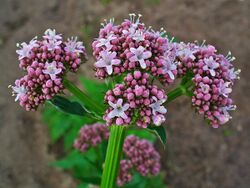Biology:Valeriana
| Valeriana | |
|---|---|

| |
| Garden valerian, Valeriana officinalis | |
| Scientific classification | |
| Kingdom: | Plantae |
| Clade: | Tracheophytes |
| Clade: | Angiosperms |
| Clade: | Eudicots |
| Clade: | Asterids |
| Order: | Dipsacales |
| Family: | Caprifoliaceae |
| Subfamily: | Valerianoideae |
| Genus: | Valeriana L. |
| Synonyms[1] | |
|
List
| |
Valeriana is a genus of flowering plants in the family Caprifoliaceae,[1] members of which may by commonly known as valerians. It contains many species, including the garden valerian, Valeriana officinalis. Species are native to all continents except Antarctica, with centers of diversity in Eurasia and South America (especially in the Andes).
Taxonomy
The genus was named by Carl Linnaeus after the Roman emperor Publius Licinius Valerianus who was said to use the plant as medicine.[2]:16 The emperor's personal name comes from Valeria and the Latin verb valeo which means "to be strong".[3][4]
Botany
Species from this genus are herbaceous and have woody roots. They grow vines with fine hairs and trifoliolate, pinnate leaves with serrated edges. They release a strong smell when they dry. Their flowers bloom from cymes.[5]
Fossil record
Fossil seeds of Valeriana sp, among them †Valeriana pliocenica, have been recovered from Late Miocene deposits of southern Ukraine , and from Pliocene deposits of south-eastern Belarus and Bashkortostan in central Russia. The fossil seeds are most similar to the extant European Valeriana simplicifolia (a subspecies of Valeriana dioica).[6]
Species
(As of December 2020), Plants of the World Online accepts over 420 species and hybrids, including:[1]
- Valeriana alypifolia
- Valeriana aretioides
- Valeriana asterothrix
- Valeriana bertiscea
- Valeriana buxifolia
- Valeriana californica
- Valeriana celtica (Alpine valerian or valerian spikenard)
- Valeriana cernua
- Valeriana coleophylla
- Valeriana dioica (marsh valerian)
- Valeriana edulis
- Valeriana fauriei (Korean valerian[7])
- Valeriana montana
- Valeriana occidentalis
- Valeriana officinalis (garden valerian)
- Valeriana pauciflora
- Valeriana pyrenaica (Pyrenean valerian)
- Valeriana secunda
- Valeriana sitchensis (Sitka valerian)
- Valeriana uliginosa
Gallery
-
V. montana
References
- ↑ 1.0 1.1 1.2 "Valeriana L.". Plants of the World Online. Royal Botanic Gardens, Kew. https://powo.science.kew.org/taxon/urn:lsid:ipni.org:names:30000719-2.
- ↑ Ilieva, Iliana (30 March 2021). "Names of botanical genera inspired by mythology". GSC Biological and Pharmaceutical Sciences 14 (3): 8–18. doi:10.30574/gscbps.2021.14.3.0050. https://gsconlinepress.com/journals/gscbps/content/names-botanical-genera-inspired-mythology.
- ↑ Harper, Douglas. "valerian". Online Etymology Dictionary. https://www.etymonline.com/?term=valerian.
- ↑ Lewis, Charlton T.; Short, Charles (1879). "vălĕo". vălĕo. Perseus Digital Library. https://www.perseus.tufts.edu/hopper/text?doc=Perseus%3Atext%3A1999.04.0059%3Aentry%3Dvaleo.
- ↑ Acevedo-Rodríguez, Pedro (April 2020). "Caprifoliaceae". Guide to the Genera of Lianas and Climbing Plants of the Neotropics. National Museum of Natural History, Smithsonian Institution. https://naturalhistory.si.edu/sites/default/files/media/file/caprifoliaceae.pdf.
- ↑ The Pliocene flora of Kholmech, south-eastern Belarus and its correlation with other Pliocene floras of Europe by Felix Yu. VELICHKEVICH and Ewa ZASTAWNIAK - Acta Palaeobot. 43(2): 137–259, 2003
- ↑ English Names for Korean Native Plants. Pocheon: Korea National Arboretum. 2015. pp. 668. ISBN 978-89-97450-98-5. http://www.forest.go.kr/kna/special/download/English_Names_for_Korean_Native_Plants.pdf. Retrieved 24 December 2016.
External links
Wikidata ☰ Q159559 entry
 |



